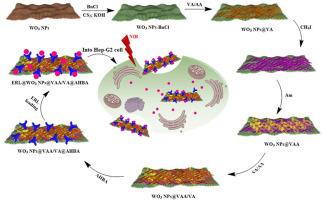Construction of a tungsten trioxide modified smart-polymers as a NIR-responsive platform for photo-thermal therapy on hepatocellular cancer
IF 4.1
2区 化学
Q2 POLYMER SCIENCE
引用次数: 0
Abstract
Cancer remains a predominant contributor to both mortality and morbidity on a global scale, with over 10 million new cases diagnosed annually. The aim of this work was to prepare and evaluate erlotinib hydrochloride loaded tungsten trioxide modified with smart polymers for their anticancer potential. The morphology, crystallinity, chemical bonding, and thermal behavior of the nanoadsorbent were characterized using field emission scanning electron microscopy, transmission electron microscopy, X-ray diffraction, Fourier-transform infrared spectroscopy, and thermogravimetric analyses. The optimization of the drug on the synthesized adsorbent was investigated utilizing response surface methodology-central composite design. The maximum sorption efficiency of 90.18 % was achieved at the initial drug concentration of 32.82 mg L−1, a pH of 8.17, a temperature of 32.93 °C, and a contact time of 16.08 min. The drug sorption process follows the Langmuir isotherm and it displays pseudo-first-order kinetics. The nanocarrier showed a significant release profile for 6 h with a maximum release percentage of 99.81 % in simulated cancer fluid at high temperatures. The nanocarrier showed low drug release without near-infrared laser irradiation and a rapid release rate over 15 min of near-infrared laser irradiation. The drug release properties fit the Korsmeyer-Peppas model, with a diffusion exponent indicative of both diffusion and erosion release mechanisms. In-vitro cytotoxicity of the nanocarrier in normal cells indicated that it had no significant cytotoxicity. The cytotoxicity of the nanocarrier in Hep-G2 hepatocellular carcinoma cell lines was evaluated by MTT assay, and the data showed that the nanocarrier has excellent cytotoxic activity (75.45 %).


三氧化钨修饰智能聚合物作为光热治疗肝癌nir响应平台的构建
在全球范围内,癌症仍然是造成死亡率和发病率的主要原因,每年诊断出的新病例超过1000万例。本工作的目的是制备和评价智能聚合物修饰的负载三氧化钨的盐酸厄洛替尼的抗癌潜力。利用场发射扫描电子显微镜、透射电子显微镜、x射线衍射、傅里叶变换红外光谱和热重分析对纳米吸附剂的形貌、结晶度、化学键和热行为进行了表征。利用响应面法-中心复合设计对所合成的吸附剂进行优化。在初始药物浓度为32.82 mg L-1、pH为8.17、温度为32.93℃、接触时间为16.08 min的条件下,吸附效率最高,达到90.18%。吸附过程符合Langmuir等温线,表现为准一级动力学。纳米载体在模拟癌液中高温释放6 h,最大释放率为99.81%。该纳米载体在近红外激光照射下具有较低的药物释放率,近红外激光照射15 min以上的药物释放速度较快。药物释放特性符合Korsmeyer-Peppas模型,其扩散指数指示扩散和侵蚀释放机制。体外细胞毒性实验表明,该纳米载体对正常细胞无明显的细胞毒性。MTT法测定纳米载体对Hep-G2肝癌细胞株的细胞毒活性,结果表明纳米载体具有良好的细胞毒活性(75.45%)。
本文章由计算机程序翻译,如有差异,请以英文原文为准。
求助全文
约1分钟内获得全文
求助全文
来源期刊

Polymer
化学-高分子科学
CiteScore
7.90
自引率
8.70%
发文量
959
审稿时长
32 days
期刊介绍:
Polymer is an interdisciplinary journal dedicated to publishing innovative and significant advances in Polymer Physics, Chemistry and Technology. We welcome submissions on polymer hybrids, nanocomposites, characterisation and self-assembly. Polymer also publishes work on the technological application of polymers in energy and optoelectronics.
The main scope is covered but not limited to the following core areas:
Polymer Materials
Nanocomposites and hybrid nanomaterials
Polymer blends, films, fibres, networks and porous materials
Physical Characterization
Characterisation, modelling and simulation* of molecular and materials properties in bulk, solution, and thin films
Polymer Engineering
Advanced multiscale processing methods
Polymer Synthesis, Modification and Self-assembly
Including designer polymer architectures, mechanisms and kinetics, and supramolecular polymerization
Technological Applications
Polymers for energy generation and storage
Polymer membranes for separation technology
Polymers for opto- and microelectronics.
 求助内容:
求助内容: 应助结果提醒方式:
应助结果提醒方式:


